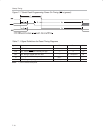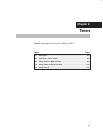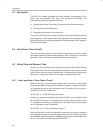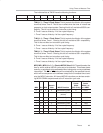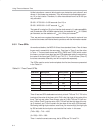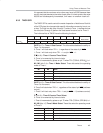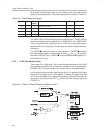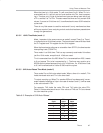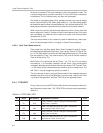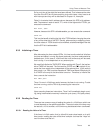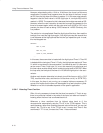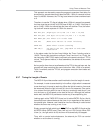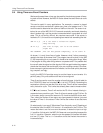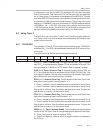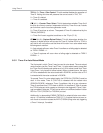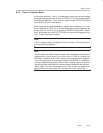
Using Timers to Measure Time
8-8
As shown, the value of TH0 never changed. In fact, when mode 2 is used, THx
is almost always set to a known value and TLx is the SFR that is constantly
incremented. THx is initialized once, and then left unchanged.
The benefit of auto-reload mode is that, perhaps, the timer may need to always
have a value from 200 to 255. When using mode 0 or 1, the code would have to
be checked to see if the timer had overflowed and, if so, the timer reset to 200. This
takes precious amounts of execution time to check the value and/or reload it.
When mode 2 is used, the microcontroller takes care of this. Once a timer has
been configured in mode 2, it does not have to be checked to see if the timer
has overflowed, nor does the value need to be reset—the microcontroller
hardware will do it all.
The auto-reload mode is very commonly used for establishing a baud rate,
which will be discussed further in Chapter 9, Serial Communications.
8.3.3.4 Split-Timer Mode (mode 3)
Timer mode 3 is a split-timer mode. When Timer 0 is placed in mode 3, it essen-
tially becomes two separate 8-bit timers. That is to say, Timer 0 is TL0 and Tim-
er 1 is TH0. Both timers count from 0 to 255 and overflow back to 0. All the bits
that are related to Timer 1 will now be tied to TH0, and all the bits related to
Timer 0 will be tied to TL0.
While Timer 0 is in split mode, the real Timer 1 (i.e. TH1 and TL1) can be put
into modes 0, 1, or 2 normally. However, the real Timer 1 may not be started
or stopped, because the bits that do that are now linked to TH0. The real Timer
1, in this case, will be incremented every machine cycle no matter what. The
real Timer 1 may be stopped by setting it to mode 3.
The only real use of note in using split-timer mode is if two separate timers are
needed along with a baud rate generator. In such a case, use the real Timer
1 as a baud rate generator, and use TH0/TL0 as two separate timers.
8.3.4 TCON SFR
Finally, there is one more SFR that controls the two timers and provides valu-
able information about them. The TCON SFR has the structure described in
Table 8−4.
Table 8−4.TCON (88
H
) SFR
Bit Name Bit Address Explanation of Function Timer
7 TF1 8F
H
Timer 1 overflow. This bit is set by the microcontroller
when Timer 1 overflows.
1
6 TR1 8E
H
Timer 1 run. When this bit is set, Timer 1 is turned on.
When this bit is clear, Timer 1 is off.
1
5 TF0 8D
H
Timer 0 overflow. This bit is set by the microcontroller
when Timer 0 overflows.
0
4 TR0 8C
H
Timer 0 run. When this bit is set, Timer 0 is turned on.
When this bit is clear, Timer 0 is off.
0



